#Simplifying Complex Data
Explore tagged Tumblr posts
Text
Embracing a New Era: The Rise of Augmented Analytics.
Sanjay Kumar Mohindroo Sanjay Kumar Mohindroo. skm.stayingalive.in Augmented Analytics simplifies complex datasets with AI-driven insights that empower business decisions through clear and actionable data interpretation. Augmented analytics transforms data interpretation by using AI-driven systems that simplify the process of turning vast data collections into clear, actionable insights for…
#Actionable Insights#AI#AI Business Applications#AI in Business Strategy#AI in Global Operations#AI-Driven Analytics#AI-Powered Business Growth#Analytics for Business Leaders#Augmented Analytics#business#Business Transformation#Clear Data Insights#Clear Data Narratives#Continuous Improvement with Analytics#Data Clarity#Data Interpretation#Data Simplification#Data-Driven Culture#data-driven decision making#digital-marketing#Empowering Decision Makers#Future of Business Analytics#Global Business Strategy with AI#marketing#Modern Business Intelligence#Predictive Analytics#Real-Time Data Insights#Sanjay Kumar Mohindroo#Simplifying Complex Data#Strategic Business Insights
0 notes
Text

✨ DISCLAIMER: science, subjectivity & shifting
. ★⋆. ࿐࿔ ✦ . . ˚ .ੈ✧̣̇˳·˖
i acknowledge that not everyone reading my “science of shifting/law of assumption” posts comes from a scientific background — or even wants to dive deep into technical explanations of the topics discussed. that’s totally okay. the content here is intentionally simplified to make core ideas more accessible, while still staying true to the scientific literature and experimental evidence cited at the end of each post.
if you’re curious to explore further, i always encourage you to read the original papers yourself — the sources are there for a reason! 🫶 my posts blend scientific findings with spiritual and metaphysical interpretation, bridging quantum physics, neuroscience, and manifestation/shifting philosophy in a way that reflects how i’ve personally experienced and understood their connection.
additionally, this isn’t a replacement for formal science — it’s an interpretive lens, a lived perspective on how consciousness interacts with reality. i write to offer clarity and reassurance, but remember: you don’t need “proof” in the traditional sense (like experiments or data charts) to believe in shifting or to experience your own power.
you ARE the proof. your subjective experience of reality is the experiment.
furthermore, science, as powerful and essential as it is, has natural limits. it cannot fully access or measure the metaphysical, spiritual, or energetic realms (whatever name resonates with you), because they transcend the physical 3D. science can only measure the projection — not the source.
it cannot yet describe the quantum field in its full multidimensionality, and it absolutely cannot quantify your unique, lived experience of reality.
that’s why concepts like shifting and law of assumption are, in a way, eternally undebunkable in the traditional scientific sense. they exist in a space that science, as a way of knowing, can’t directly access, and that’s okay.
so if you’re here looking for conventional evidence to “prove” shifting or manifestation in a materialist, lab-confirmed sense — you won’t find it. and that’s not a flaw. that’s the nature of reality itself.
science and spirituality are not opposites. they are two sides of the same coin. two perspectives trying to describe the same infinitely complex field of potential we call reality.
you’re allowed to trust your experience of that, even when it defies measurement.
. ★⋆. ࿐࿔ ✦ . . ˚ .ੈ✧̣̇˳·˖
and finally — if concepts like shifting or the law of assumption don’t resonate with you, that’s okay! as i always emphasize: reality is subjective. you get to shape yours, just as i shape mine.
if this content doesn’t align with your beliefs, that’s totally valid! but it might also mean this page simply isn’t for you, and that’s okay too. i lovingly ask that you refrain from negative interactions or debate just for the sake of conflict.
i’m always open to clarifying or expanding on what i’ve written, sharing how i personally interpret the scientific + spiritual correlations i’ve come across. but i’m not here to entertain dismissiveness, arguments, or “gotcha!” energy from people who aren’t open to this perspective in the first place.
this is not a peer-reviewed scientific journal — it’s literally a blog about the law of assumption, reality shifting, and manifestation. if that’s not for you, that’s totally okay. that’s your reality — not mine.
i do my best to protect my peace and the energetic tone of this online space. this blog is about love, light, empowerment, and possibility — not convincing skeptics or debating people who’ve already decided they don’t believe in it.
so if you’re here with curiosity, openness, or the desire to expand your understanding of self + reality, you’re always welcome. if not, that’s okay too.
love and light either way! <3
. ★⋆. ࿐࿔ ✦ . . ˚ .ੈ✧̣̇˳·˖
🤍 p.s. i had a brief version of this disclaimer on my “science of shifting” series directory for a while, but thought i’d make a full post to go more in depth! i hope this brings more clarity and grounding! shifting/law of assumption is a personal, spiritual journey — so lovingly, your limiting beliefs or skepticism? not my business to entertain 🥹
#law of assumption#loassblog#affirm and manifest 🫧 🎀✨ ִִֶָ ٠˟#loassumption#loa tumblr#affirm and persist#affirmations#how to manifest#living in the end#4d reality#neville goddard#void state#shifting tips#shifting blog#shifting motivation#shiftingrealities#shifting realities#shifting#shifting community#shiftblr#reality shifting#desired reality#loablr#lawofassumption#loa blog#loa advice#loass#law of manifestation#law of assumption motivation#manifesation
132 notes
·
View notes
Note
I read the Young Wizards series when I was probably 10 or 11, and absolutely loved it. Specifically Deep Wizardry was incredibly important to me; it was a huge push for me to get interested in the ocean and how humans affect it.
Thank you for writing such a wonderful series, especially one that didn't simplify the complex emotions and experiences children go through. Childhood was an extremely dark point in my life, but I consistently remembered your books as a comfort and reassurance of the goodness and sheer interesting-ness of the real world. I cannot express how fascinated and joyful the world you built in those stories made me.
I've started my re-read of So You Want To Be A Wizard today, at age 20. The writing still holds up to adult-me, and I'm enjoying the book all over again. I'm looking forward to reading Deep Wizardry again especially; I'm three years into studying Oceanography and Biology.
Thank you so very, very much.
You're entirely welcome. I'm very glad the books were there for you when you needed them.
As for Deep Wizardry, at the oceanographic end— The amount of go-to-the-New-York-Public-Library-and-dig-out-the-data research I had to do for that astonishes me to this day. It was a long time before Google, and the only source of data for much of the background needed was NOAA stuff that was locally publicly available only there. (Some more info on that in this post.) The lack of even very basic maps such as this one (published three years after DW was) forced me to handcopy and merge data from various sources into homebrew mapping notes like this.

...So I have to say it's nice to discover that this doesn't stack up too badly against more modern mapping resulting from much better data. :)
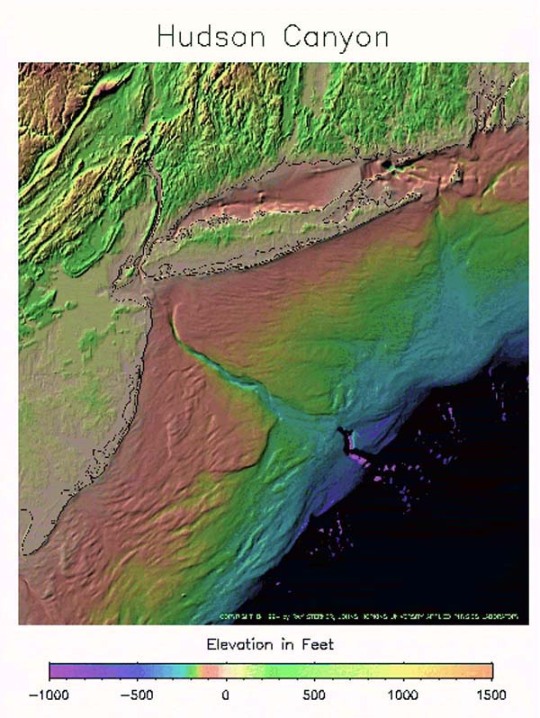
And this area is apparently still on track to become a national marine sanctuary, assuming nothing goes wrong with the process secondary to yesterday's unfortunate events.
Anyway: do enjoy your reread! And thanks for letting me know about your endeavors. :)
163 notes
·
View notes
Text

Simplifying the Centrolene buckleyi complex (Amphibia: Anura: Centrolenidae): a taxonomic review and description of two new species
Franco-Mena, De la Riva, et al
Abstract
Centrolenidae is a Neotropical family widely distributed in Central and South America, with its species richness concentrated in the tropical Andes. Several taxonomic problems have been identified within this family, mostly related to species with broad geographic distributions. In this study, we assessed and redefined the species boundaries of the Centrolene buckleyi species complex, and formally described two new species from the Andes of Ecuador. These new taxa are recognized by a combination of morphometric, osteological, acoustic, and genetic data. Following IUCN criteria, we propose that the two new species should to be considered as Endangered (EN), mainly because of their small distributions and habitat loss. The C. buckleyi complex provides insights into the biogeography of closely related Andean species. As in other glassfrogs, speciation in Centrolene seems to be mediated by the linearity of the Andes, where gene flow can be restricted by topography and, also, local extinctions.
Read the paper here:
Simplifying the Centrolene buckleyi complex (Amphibia: Anura: Centrolenidae): a taxonomic review and description of two new species [PeerJ]
128 notes
·
View notes
Text
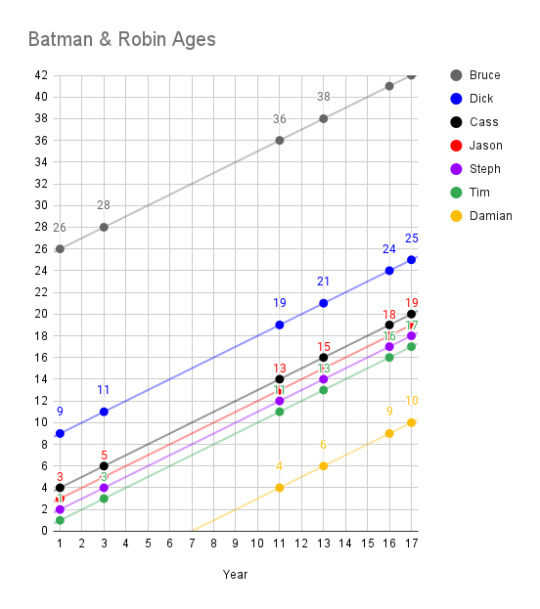
i'm the kind of person who makes spreadsheets for fun, so here's a chart showing the approximate ages of the batfamily relative to major events pre-reboot:
year 1: bruce becomes batman
year 3: dick becomes robin
year 11: dick becomes nightwing, jason becomes robin
year 13: jason dies, tim becomes robin
year 16: jason becomes red hood
year 17: bruce 'dies,' dick becomes batman, tim becomes red robin, damian becomes robin
i excluded alfred, because his data would have made the graph difficult to read, and duke, because he didn't exist pre-boot therefore his age can't be calculated using the same points of reference (however we know his age is between tim and damian). overall this is a very simplified interpretation, based on more complex analyses done by other fans.
#ask me about my process 🤷🏻♀️#most of these numbers can +/- a year or so depending on what you headcanon#but if you stray too far things start to get Fucked Up#not that that's ever stopped dc writers...#batman#batfamily#bruce wayne#dick grayson#jason todd#tim drake#damian wayne#cassandra cain#stephanie brown#dc comics
334 notes
·
View notes
Note
hey..
at what point do collectors opt to turn things from puppets to scrolls? I feel like turning an entire living creature into [a piece of paper] is very complicated, while turning them into simple puppets is easier because they keep all the same parts, just simplified and wood?
It is! It depends on the person's proficiency and understanding of the mechanism regarding when and how they change the creature. Once someone gets good at it, the creature can be transformed into a lifeless object without it dying in the process, and they will move on to more complex and efficient ways.
The way I see it, archiving is a form of information compression and storage—and there is A LOT of information. When looking at Earth creatures we have everything from single-cell bacteria to whales that range up to 100 quadrillion cells, all with different sizes. The smallest single-cell critter is 0.3 μm, while the largest single cell is an ostrich egg that can get to 18 cm. So it's not just noting "a cell"—there's also a lot of information about the cell content, size, the DNA, current water, and oxygen levels, what protein it contains and how much. Then there are spatial dimensions. (While we can consider there being more, especially in fiction, I’m sticking to three; trying to visualize four fills me with frustration and existential dread xD) Every cell has its place in space in relation to the others, and all the contents' relations are also important. If, suddenly, all histones materialize inside a mitochondria instead of the nucleus, we can have a problem. Additionally, physical and chemical processes gotta be considered. There's electricity powering our brains, hearts, running nerves, air in airways traveling to lungs, chemical signals traveling between synapses that also need to be accounted for. So, you have all the contents in space, their vectors, and building blocks. Thats a ton to save. This information has to be compressed to be preserved in an organized manner while also remaining lossless so that when returned to its original shape, it's as it was. Not even mentioning that in intelligent beings, there are also minds to take care of. Jellyfish might be fine after 100 years in a static void, but a human? Yhhhhh.
I think the mechanism would work by saving information in intangible magic and assigning it to a physical medium—be it a statue, doll, book, or scroll. If it is physical and can carry information, it can be used. We can argue the mind is part of the soul, or it is a biochemical process, but the fact is nobody really knows for sure what it is and Im not a theolog, so for the sake of this universe, I'll say it's something that occupies the same space magic does and is influenced by chemical processes, meeeeaning it can also be tricked by them. And the magic.
The first degree of preservation would be spells that only change the material but keep all shapes and info in place. This wouldn't require much thought while executing and could be "automated" or worse, taught to mortals (if they have enough magic to power the spell), like petrification or changing someone into wood, metal, or any other solid material. It's not perfect, if the structure is damaged, the spatial information is damaged too. Breaking is one thing, but imagine if the statue melts.
The next step would be assigning objects with some compression and change, like toys and dolls. I feel like there would need to be a system like a content library, so not every single atom is saved each time, but chemical structures like nucleotides in DNA (the ATGC thingies) would just have a shortcut. Larger repeating patterns could also be assigned their own id to save data, and it would slowly stack up. While things are written in intangible magic form and anchored to the medium, the medium can be somewhat customized, like the decorations the Collector added to the dolls. The mind, running in controlled magic, can also be affected, as we saw with Collie trying to scare them and Luz’s dream. On the spell keeping the preserved critter stable has a link to what shortcut it uses so with countless diffrent worlds and structres it wouldnt mix up.
Then we go further into compression, reducing size and dimensions until we reach a point where one axis is almost entirely removed, and we end up with a scroll. Then there are other things—creatures saved as amber miniatures, snow globes, scrolls, or drawings, sometimes purely to annoy the sibling that has to deal with the creature in unhandy form. A more permanent binding would be in a book that can contain a bunch of different animals. Rebinding for long-term preservation is the Curator’s job.
Looking at Earth creatures, eucariotic life shares ancestry with some ancient bacteria that decided to rebel and started to cooperate, so we share similarities even with distant organisms in some strutures since they come from each other. So when it comes to preserving whole populations with relations, the library of compression doesn’t have to be separate for every single animal or plant. For each section of the archive, there would be a common library of building blocks, and scrolls being somewhat separate carrying the exact instructions for body arrangement and the soul/mind/the part that makes them alive attached.
Next is unpacking the information. I think this requires the ability to interpret and recreate what was saved that mortals lack. While they couldn't really unpetrify others, a collector could (assuming the mind hadn’t deteriorated into a husk). In the case of an automated spell, I think it would result in a very lossy transmutation—like a jpg losing pixels, the creature might lose like heart funtion. The Collector's spell also looked temporary or incomplete since an influx of other types of magic (like in Amity or Raine’s case) was able to push back on it. That might also be why they were conscious in the form they were in. Not meant for long just enough to take them to archive in normal conditions. When a creature is heavily compressed, it needs external force to rebuild, as it's essentially written fully in magic. That’s what I think happened to the Owl Beast. Lilith released it from the medium, but since it wasn’t fully rebuilt, it being a magic form attached itself to a magic source.
SO YEAH, its a process that takes quite a while for them to master and it comes with experience. But when experience is based on life it often makes it hard to practice so those with less empathetic approach master it faster. Thanks for the ask! I was dying to talk about that for such a long time and that was a perfect thing to organise thoughts
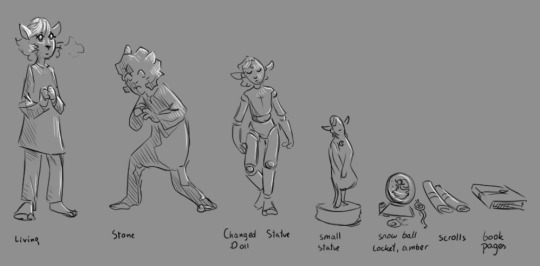
#and consider the absolute body horror that is transmutation#imagine how it has to feel on the border of skin that is being turned to stone when nerve endings cant send what is happening#but can send the numbness of “there is something super wrong” like in severe frostbite#both must feel like tissue dying#tw body horror#i did not use that one in a moment#In the begining i had a concept that it all saves the same way like a doll so diffrent archivists would have diffrent methods#like Anatomist using scrolls Wayfarer drawings and so on but then realised that would be super unhandy when a book carries more info#and its easier to fix a doll than a scroll so settled on this#thats also why in the comic where Way damaged creature they were turned into a doll Way was just very unexperienced with archiving spells#Collection Incomplete au#the owl house#owl house#toh#the collector#toh collector#toh archivists#the archivists#toh collectors#ask#i took sleeping meds before writing this safe to say they didnt work
60 notes
·
View notes
Text
Trump and Palantir Forge a Pan-Government Surveillance State, Empowering Tech Oligarchs and Silencing Critics
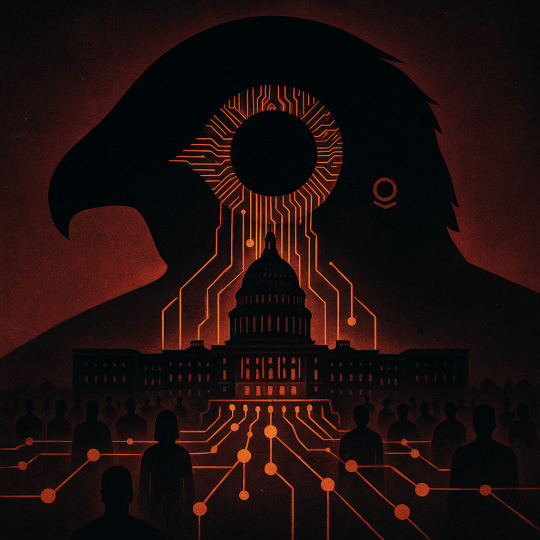
Source article for analysis: https://newrepublic.com/post/195904/trump-palantir-data-americans
1. Narrative Framing
Simplicity & “Common-Sense” Appeal The administration casts cross‐agency data‐sharing as an efficiency and “government modernization” measure, flattening complex privacy and constitutional concerns into a feel-good story about bureaucratic streamlining. This preloads the conclusion that any objection is mere technophobia or red tape, rather than a debate over surveillance power.
Binary Framing (“Security vs. Chaos”) By emphasizing “national security” and “public safety,” critics are implicitly positioned as indifferent to immigrant crime or terrorism, pressuring dissenters to choose between safety and liberty—an either-or that forecloses nuanced policy discussion.
2. Emotional Engineering
Fear & Resentment References to “enforcing the March executive order,” “punish his critics,” and fears of immigrant targeting stoke anxiety about arbitrary state power. This fear is then channeled into loyalty among “true patriots” who trust the administration to wield that power wisely.
Pride & Tribal Bonding Invoking a “war on inefficiency” and naming a “far-right billionaire” ally provides a rallying narrative for supporters who see themselves as part of an inner circle, engendering pride in being on the “winning team.”
3. Pipeline On-Ramps & Ecosystem Mapping
Soft Entry via “Modernization” Pitches around “data modernization” and “innovation” serve as gateway content—memes and soundbites in tech-oriented outlets gradually introduce audiences to more radical surveillance proposals.
Content Funnel
Friendly tech press (“efficiency gains”)
Conservative opinion pieces (“keep America safe”)
Policy white papers and FOIA-leaked memos (“full database blueprints”)
Private sector deep dives (Palantir user groups, DOD contractor briefings)
4. Dog Whistles & Euphemisms
“National Security” Sanitized language for mass surveillance and immigrant tracking.
“Data-Driven Governance” A euphemism that hides the indiscriminate collection of personal information under the veneer of neutral analytics.
“Government Efficiency” Code for centralizing power and reducing agency-specific safeguards that currently protect civil liberties.
5. Archetypes & Mythos
Tech-Militarist Savior Casting Peter Thiel and Alex Karp as modern “warrior-lords” of data who will “defend” America—evoking the warrior archetype that simplifies identity into a battle of “us vs. them.”
Fallen Homeland Narrative Suggests America’s institutions are backward and corrupt, needing a techno-strongman to resurrect core values—mirroring the “rise-from-ruin” mythos common in alt-right rhetoric.
6. Strategic Impact Assessment
Real-World Mobilization This intel could be used to silence dissidents (through audits, visa denials, or targeted prosecutions), chill protest activity, and surveil immigrant communities disproportionately.
Beneficiaries & Victims Tech oligarchs (Thiel, Musk) and the Trump political machine gain concentrated power; critics, immigrants, student activists, and labor organizers become object lessons.
7. Vibe Warfare & Identity Signals
Stoic Realist Aesthetic Dark, angular visuals of data centers and code screens reinforce a mood of uncompromising techno-authority.
“Based” Tech Patriotism Pittings of “innovation bros” vs. “liberal elites,” using jargon (“Foundry,” “Grok”) as in-group markers to foster parasocial loyalty among tech-savvy conservatives.
8. Epistemic Booby Traps & Self-Sealing Logic
“If you have nothing to hide…” Pre-emptively discredits objections by labeling them paranoia or disloyalty, barring dissenting evidence from being taken seriously.
Data as Truth Presents analytics as inherently objective, making any critique of methodology or oversight seem “anti-science.”
9. Irony Shielding & Tone Drift
Tech-Bro Irony Occasional self-deprecating jokes about “big brother” memes allow participants plausible deniability (“We’re just goofing, who doesn’t love tech?”), while the surveillance machinery locks in.
Memetic Alchemy Use of playful GIFs or “dank” one-liners about “tracking your ex’s Starbucks habit” masks the seriousness of mass data collection.
#politics#you are not immune to propaganda#fuck maga#technology#tech bros#us politics#elon musk#fuck elon#palantir#trump#immigration#surveillance#narrative warfare
17 notes
·
View notes
Text

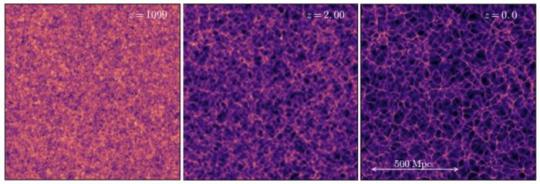
Dark energy 'doesn’t exist' so can't be pushing 'lumpy' Universe apart – study
One of the biggest mysteries in science – dark energy – doesn't actually exist, according to researchers looking to solve the riddle of how the Universe is expanding.
For the past 100 years, physicists have generally assumed that the cosmos is growing equally in all directions. They employed the concept of dark energy as a placeholder to explain unknown physics they couldn't understand, but the contentious theory has always had its problems.
Now a team of physicists and astronomers at the University of Canterbury in Christchurch, New Zealand are challenging the status quo, using improved analysis of supernovae light curves to show that the Universe is expanding in a more varied, "lumpier" way.
The new evidence supports the "timescape" model of cosmic expansion, which doesn't have a need for dark energy because the differences in stretching light aren't the result of an accelerating Universe but instead a consequence of how we calibrate time and distance.
It takes into account that gravity slows time, so an ideal clock in empty space ticks faster than inside a galaxy.
The model suggests that a clock in the Milky Way would be about 35 per cent slower than the same one at an average position in large cosmic voids, meaning billions more years would have passed in voids. This would in turn allow more expansion of space, making it seem like the expansion is getting faster when such vast empty voids grow to dominate the Universe.
Professor David Wiltshire, who led the study, said: "Our findings show that we do not need dark energy to explain why the Universe appears to expand at an accelerating rate.
"Dark energy is a misidentification of variations in the kinetic energy of expansion, which is not uniform in a Universe as lumpy as the one we actually live in."
He added: "The research provides compelling evidence that may resolve some of the key questions around the quirks of our expanding cosmos.
"With new data, the Universe's biggest mystery could be settled by the end of the decade."
The new analysis has been published in the journal Monthly Notices of the Royal Astronomical Society Letters.
Dark energy is commonly thought to be a weak anti-gravity force which acts independently of matter and makes up around two thirds of the mass-energy density of the Universe.
The standard Lambda Cold Dark Matter (ΛCDM) model of the Universe requires dark energy to explain the observed acceleration in the rate at which the cosmos is expanding.
Scientists base this conclusion on measurements of the distances to supernova explosions in distant galaxies, which appear to be farther away than they should be if the Universe's expansion were not accelerating.
However, the present expansion rate of the Universe is increasingly being challenged by new observations.
Firstly, evidence from the afterglow of the Big Bang – known as the Cosmic Microwave Background (CMB) – shows the expansion of the early Universe is at odds with current expansion, an anomaly known as the "Hubble tension".
In addition, recent analysis of new high precision data by the Dark Energy Spectroscopic Instrument (DESI) has found that the ΛCDM model does not fit as well as models in which dark energy is "evolving" over time, rather than remaining constant.
Both the Hubble tension and the surprises revealed by DESI are difficult to resolve in models which use a simplified 100-year-old cosmic expansion law – Friedmann's equation.
This assumes that, on average, the Universe expands uniformly – as if all cosmic structures could be put through a blender to make a featureless soup, with no complicating structure. However, the present Universe actually contains a complex cosmic web of galaxy clusters in sheets and filaments that surround and thread vast empty voids.
Professor Wiltshire added: "We now have so much data that in the 21st century we can finally answer the question – how and why does a simple average expansion law emerge from complexity?
"A simple expansion law consistent with Einstein's general relativity does not have to obey Friedmann's equation."
The researchers say that the European Space Agency's Euclid satellite, which was launched in July 2023, has the power to test and distinguish the Friedmann equation from the timescape alternative. However, this will require at least 1,000 independent high quality supernovae observations.
When the proposed timescape model was last tested in 2017 the analysis suggested it was only a slightly better fit than the ΛCDM as an explanation for cosmic expansion, so the Christchurch team worked closely with the Pantheon+ collaboration team who had painstakingly produced a catalogue of 1,535 distinct supernovae.
They say the new data now provides "very strong evidence" for timescape. It may also point to a compelling resolution of the Hubble tension and other anomalies related to the expansion of the Universe.
Further observations from Euclid and the Nancy Grace Roman Space Telescope are needed to bolster support for the timescape model, the researchers say, with the race now on to use this wealth of new data to reveal the true nature of cosmic expansion and dark energy.
TOP IMAGE: This graphic offers a glimpse of the history of the Universe, as we currently understand it. The cosmos began expanding with the Big Bang but then around 10 billion years later it strangely began to accelerate thanks to a theoretical phenomenon termed dark energy. Credit: NASA
LOWER IMAGE: This graphic shows the emergence of a cosmic web in a cosmological simulation using general relativity. From left, 300,000 years after the Big Bang to right, a Universe similar to ours today. The dark regions are void of matter, where an ideal clock would run faster and allow more time for the expansion of space. The lighter purple regions are denser so clocks would run slower, meaning under the "timescape" model of cosmology that acceleration of the Universe's expansion is not uniform. Credit: Hayley Macpherson, Daniel Price, Paul Lasky / Physical Review D 99 (2019) 063522
33 notes
·
View notes
Text
Writing Scientist Characters
this post is mainly an excuse to post a certain list of lab supplies I've made for a friend and infodump about lab work. but feel free to use this as a little resource when writing characters who are scientists and/or lab nerds. who knows, maybe it'll be of use.
General thoughts
Many people think it's a stereotype that scientist or nerd characters talk using complex technical jargon. While that is true to an extent, there actually is some kind of lab jargon. It varies across different labs and fields, but one thing they have in common is that it seeks to simplify, not the other way around.
gelelectrophoresis becomes elpho
microbiology becomes mibi
deioninized water becomes aqua dist
biochemistry becomes BC
sodium hydroxide becomes NaOH
They will probably not call a glass of water "silicon dioxide and h2o".
...and more. feel free to get creative. If you're writing in any other language than English, you can throw in one or two anglicisms as well. Also, most scientists will never gatekeep their work, and in an opposite fashion, will not shut up about it unless you make them. And no, most chemists do not know the entire periodic table by heart, only the most relevant elements. (main groups and a few commonly used metals of the subgroups) When it comes to characters doing the lab work, keep in mind that there are a lot more people involved than the scientist themself. Most scientists are more occupied with paperwork and data analysis, it is the laboratory technicians and assistants that do most of the practical work. They often have more lab experience than the scientists themselves.
Things you can have your lab nerd character do instead of making random chemicals explode
writing a lab report (and losing their mind over excel)
degreasing the glass bevel stoppers
removing the permanent marker from beakers (labeling is important)
complaining about the lack of funding of [their field] research
cleaning glassware
preparing specimen for examination
googling the most basic equations for their report
checking if the glassware and utensil collections are complete
steal single use plastic pipettes from their lab
pirating expensive textbooks
A list of laboratory supplies and utensils you can have them work with
Laboratory general (chem + bio)
Erlenmayer flasks, beakers, precision scales (3 digits), glass rods, metal spoons/spatulas, screw on glass flasks (autoclave compatible) test tubes, stopcock grease, dispensers with sanitizer and hand cream, gas burners, heating plates, eppendorf pipettes, pipette tips, Peleus pipetting aids, squirting bottles, liquid and powder funnels, incubator/drying chamber, round watch glasses, magnet stirring plates.
Microbiology Autoclave, petri dishes, agar plates, innoculation loops (reusable and metal), clean bench, microscope slides, microscope, drigalski-spatula, test tubes with clamping lids
Histology
Paraffin bath, water bath, scalpels, scissors, razor blades, microtomes (rotating microtome, slide microtome and freezing microtome), histocinette, tweezers (various kinds), ocular
Biochemistry
Sequencing robots, eppendorf tubes, gelelectrophoresis chambers, centrifuge
Analytical Chemistry
Photometer, kuvettes, burettes, mass spectro meters, UV bank (for chromatogrophies), pyknometers, melting point meter, porcelain mortars, pH paper, analytical scales (4 or more digits)
Prep Chemistry
Tripod/standing material, miniature lifting platforms, spiral condenser, colon condenser, round bottom flask (three necked and y- necked), filtration material, Separating funnel
Electrical engineering
Electric generators, Soldering iron, Clamp connectors, plugin connectors, ohm’s resistors, plug in lamps, condensers, transistors, PCBs, amperemeters, voltmeters, multimeters
Mechanics
Tripod/standing material, metal hooks, metal rods, mechanical stop watches, marbles, metal springs, Newton meters, laser motion detectors
Optics
Prisma (various kinds), various glass lenses (concave, convex, biconcave, biconvex), laser pointers, optical bench, mechanical iris diaphragm, looking glasses, monochrome lamps, lamp filters
Most used chemicals
Deionized water, ethanol, NaOH, HCl, H3PO4, NaCl (+ physiological NaCl solution 0.9)
Useful websites for writing science stuff
DNA sequence generator (simple): http://www.faculty.ucr.edu/~mmaduro/random.htm
DNA, RNA and protein sequence generator: https://molbiotools.com/randomsequencegenerator.php Annealing temperature calculator: https://tmcalculator.neb.com/#!/main
Medicine name generator: https://www.fantasynamegenerators.com/medicine-names.php Anything chemistry related: https://www.wolframalpha.com/input?i=chemistry
Commonly used software:
MS Excel
Yenka
CASSY Lab
LabView
SpectraLab
LIMS
LaTex
Slack
Scientist friends, feel free to add onto this.
Have fun writing!
#creative writing#writing#resource#writing resources#science#biology#chemistry#physics#writing guide#writers on tumblr#writeblr#rp#rp resources
117 notes
·
View notes
Text
Do you think the DCAs will always feel incomplete and limited among humans because we are biased and unable to understand the world to its fullest extent without simplifying it so our poor little organic brains won't implode, but they are advanced AIs with the possibility to store endless amounts of datas and need a full complex explanation for everything around them, that not even the internet can provide because it only contains the fragments of our history and experiences we were able to archive, filtered through our human limited understanding of those things?
27 notes
·
View notes
Text
Hello. You might have seen this floating around on twt:
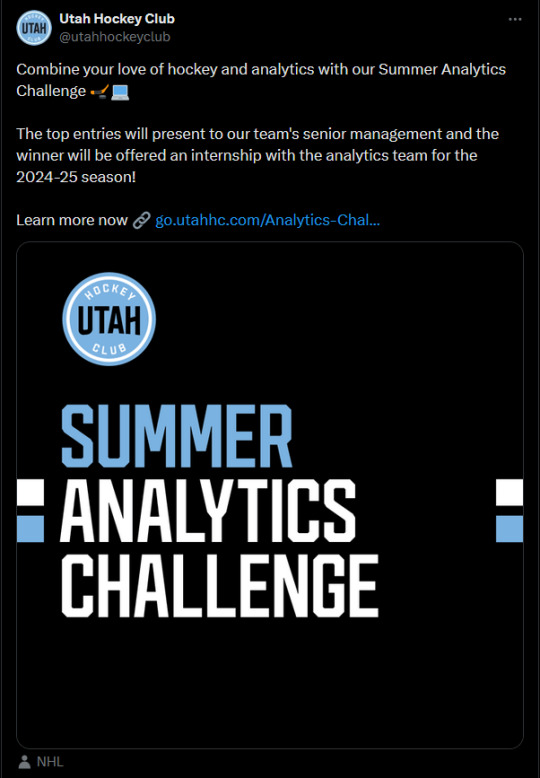
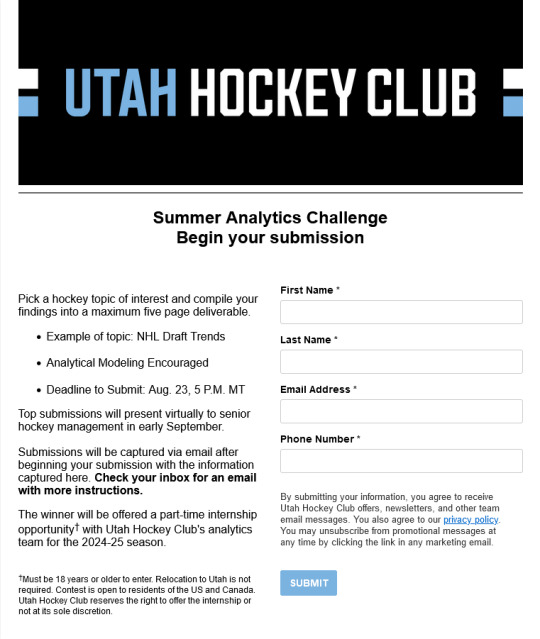
link 1 // link 2, archive link
If by any chance you or someone you know are thinking about joining in on the challenge… no one can stop you but I implore you as someone who makes art, as someone with friends in an often-exploited creative industry, as someone who lives in late stage capitalism alongside you and has seen this play out before: proceed with caution.
Read the fine print on that form. There is NO guarantee of an internship, much less a job at the end of it. I haven't gone further than this form, but if anyone reading this does, and if there's no written agreement that your work won't be used without credit to you + payment for services rendered - RUN.
This is a common corporate tactic to get free labor out of people. I'm not saying this is necessarily what’s happening; for all we know this was done as a completely innocent move to drum up some fan engagement and as a genuine search for talent for their analytics team. WHO KNOWS. But I can't ignore that I’ve seen this situation play out again and again, at every scale.
Job interviews, when they ask you how YOU think they should improve their systems, how YOU would solve their problems? When they require that you do some problem-solving for them, and it goes beyond a simple task? That’s a free consultation you’re giving them, that's free work you or someone else should be getting paid for.
When big streamers/influencers ask their fans to join in on a fan art contest to choose their new pfp/banner? That’s hundreds, possibly thousands of pieces of free art they never would’ve gotten otherwise. They could've gone to the trouble of paying someone in-house to do it, hiring someone for that position, commissioning a professional for a piece. It's free work from their dedicated fans.
In this case, Utah HC is asking fans to not only choose/provide their own dataset, but to do a complex analysis on it AND do the work of visual and verbal communication to senior management, who likely do not have a deeper grasp of the concepts and will need it simplified. The stipulation that you will present your work could be ANYTHING!! The "five page deliverable" is already bananas to me, having dipped my toe into what analytics is and how complex the fun ones are. Condensing it all is WORK. The presentation portion may include speaking time and answering questions; the groundwork for doing this effectively may include producing data visualisations, making spreadsheets, time consuming write-ups. Maths and science communication is hard. It is WORK. They are asking for free labor.
Many have already called it out, but it's still gaining traction via retweets from big accounts uncritically sharing it. I found out through the official Puckpedia account. Jack Han called it out pretty eloquently on twitter and on his substack:
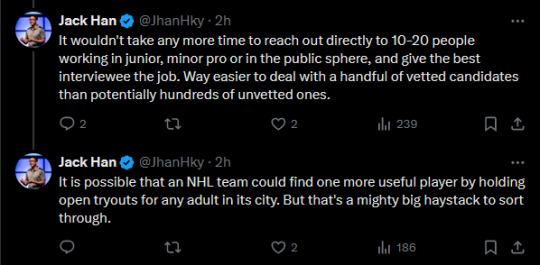
Many people aspire to work as an analyst in the NHL. Earlier today the Utah Hockey Club gave those people a glimmer of hope. Utah’s Summer Analytics Challenge is unusual in that it doesn’t provide a dataset or detailed instructions. The open-ended contests contrasts with other public (ex: Big Data Cup) or private (ex: NHL team interview) events. In those scenarios, participants are given proprietary data to clean, model and analyze, which influence direction and methodology. Meanwhile, Utah is seemingly happy with anything as long as the writeup is under five pages long. Utah’s contest also stands out in its near-total absence of legal fine print. There are no mention of intellectual property implications, which is perhaps fitting when the team is asking participants to bring their own data and analysis. [...] Open casting calls such as Utah’s analytics challenge start out as a lose-lose-lose proposition: > The employer loses because it will have to invest massive human resources to trawl/filter/evaluate/reverse-engineer the hundreds of write-ups it is sure to receive, with no guarantee that any of them will be of use > Applicants lose because the vast, vast majority of them will have nothing to show for their efforts, while a tiny minority risks having its IP stolen > Good ideas lose because they’ll be born into an environment where their parents (the applicant & the employer) have no defined relationship and won’t be in a position to grow together
link, archive link
I do try to keep things light on this blog, but this is super personal for me <3 thank u for listening
#so glad the majority of the reaction to this has been to shit on it tbqh. GET THEIR ASSES#TRYING OUT ADDING ARCHIVE LINKS WHEN I CAN !! FUCK WEBROT!!! AND FUCK THEM IF THEY TRY TO DELETE THE EVIDENCE!!!#Utah HC#Utah Hockey Club#puckposting
38 notes
·
View notes
Text
youtube
We sit down with Greg, CEO of Buyist Pro, to explore how AI is transforming the online shopping experience.
Greg shares his passionate perspective on AI's role in solving eCommerce's fundamental problem: complexity. He explains how Buyist Pro uses AI to simplify the complicated web of credit card processing, order fulfillment, customer service, and website management. While acknowledging AI's current limitations, Greg emphasizes that it's "already good enough" and improving constantly. We discuss how AI's ability to process vast amounts of platform data and respond to natural language queries makes it a game-changing tool for online retailers.
Chapters 0:00 Intro 0:24 How Buyist uses AI for eCommerce 2:55 The Buyist Pro Advantage 4:02 Overcoming The Problems With AI 5:04 Using AI for eCommerce
Join us for our next episode, where we'll dive deeper into the future of eCommerce platforms.
21 notes
·
View notes
Text
ERP Confusing You? You Might Just Need the Right Partner.
You didn’t choose NetSuite for complexity. Furthermore, you chose it to simplify, streamline, and scale.
But here’s the plot twist most Toronto businesses discover too late: NetSuite doesn’t run smoothly unless it’s set up intentionally.
A lot of companies install NetSuite like it’s plug-and-play. It’s not. You need a partner who understands how your operations, people, and data actually connect.
That’s where Haya Solutions comes in.
As a trusted NetSuite Partner in Toronto, we help businesses move from ERP overwhelm to ERP clarity. What that means: Tailored setup — not just “templates” Customized modules, fields & reports that make sense for your team Integration with the tools you already use Local support in the same time zone, speaking your language
No more bouncing between IT tickets. No more guessing which report is correct. Just a system that fits your business like a glove.
Real Talk: NetSuite isn’t just about data. It’s about decisions. Better dashboards. Real-time tracking. Forecasting you can actually trust.
If your ERP feels like a mess of menus and half-working workflows, it’s time to stop settling.
Partner with someone who doesn’t just know NetSuite — but knows how Toronto businesses operate.
That’s the difference between software and strategy.
#NetSuitePartnerToronto#HayaSolutions#ERPExperts#BusinessConsulting#DigitalTransformation#SmartERP#TorontoBusiness#TumblrMicroblog#TechThatWorks
11 notes
·
View notes
Text
The CBO seems to cherry-pick results either to create headlines or to justify its existence with elaborate reports that make them appear credible. But they aren’t.
On June 3 we read an article by Jay Davidson that the CBO thinks Trumps “Big Beautiful Bill” will increase the deficit by $3.8 trillion over 10 years. Color me skeptical. The CBO has absolutely zero inkling for how this bill will actually change the economic landscape of America over the next 10 years. Sure, a high-schooler can do the math of estimated federal income versus proposed spending, ignorantly assuming nothing else changes over the next 10 years, and come up with a number. After all, growth in the deficit is simply the result of cumulative spending more than cumulative receipts.
But now the CBO thinks the tariffs will decrease the federal deficit by $2.5 trillion. So, in a matter of days, we went from $3.8 trillion addition to the deficit to $2.5 trillion reduction of the deficit? How can that be?
The CBO arms itself with all kinds of really cool charts, graphs, and tables that are probably morphed into a computer simulation because no one person (except those with the last names “Trump” and “Musk”) could possibly reduce all these variables into a single prediction model. The CBO references such things as the “Global Trade Analysis Project (GTAP) model,” “Input-Output Accounts Data,” “A Simplified Model of How Macroeconomic Changes Affect the Federal Budget,” etc.
But all they have proven recently is they’re just guessing. All those “climate scientists” also justify their predictions using complex computer models that no mere peasant could possibly understand, so we are to “trust the science.” Except none of us have notice the oceans swallowing up coastal cities yet.
6 notes
·
View notes
Note
in gallifreyan, whichever scripts, how do they write coordinates, be it time or displacement? Or planet relative calendar dates.
How do Time Lords write coordinates?
There's a bit of contradictory information and things that don’t make much sense when it comes to space-time coordinates and Gallifreyans, but here’s an answer I hope will sate your curiosity, with plenty of background:
🔑Key Parts of the Coordinate System
Spatial Coordinates: These specify locations in three-dimensional space relative to Galactic Zero Centre (Gallifrey’s Eye of Harmony, basically, or at least somewhere near it). They usually consist of Vector and Quadrant particles.
Temporal Coordinate: This indicates time, relative to Gallifrey’s present (whatever that’s supposed to mean! I would probably assume that while Gallifrey went walkies, the Doctor's TARDIS either used temporal coordinates relative to Event One (the creation of the universe), or otherwise fixed it at a certain Gallifreyan date. There are also specialised TARDIS instruments which can be calibrated help skip the temporal coordinate stuff and make the input relative to the planet).
Universal Coordinate: This designates the specific universe required.
Epsilon Coordinates: Calculated paths through the Space-Time Vortex, usually handled by a TARDIS automatically.
Flight Data: Details about departure and destination points.
🚀Space-Time Coordinates Format
Space-time coordinates consist of fifteen digits. Using these two combined below will get you to the right star system:
Vector (2 digits): Indicates the broad direction.
Quadrant (2 digits): Specifies the quadrant within the galaxy.
Using these two below in addition will get you a more precise location, and a time:
Exact Spatial Location (7 digits): Detailed coordinates within the quadrant.
Temporal Location (4 digits): Relative to Gallifrey’s present (you'll obviously need to be longer to be more precise).
🌍Example
Let's have a crack with Earth’s galactic coordinates. We know the Earth’s Galactic Coordinates are 5804 4684884:
Vector: 58, Quadrant: 04 (solely on these you’ll reach Mutter’s Spiral)
Exact Spatial Location: 4684884 (add this and you’ll reach Earth)
Temporal Location: 9182 (+9182 time units from Gallifrey’s present)
The Flight Data Monitor will simplify this. Assuming a journey from Earth to fictional Zargon 3, your TARDIS monitor will display something like this:
Departure Planet: Sol 3 (Earth) [Dimension 01] Location: London, England Local Dateline: 2024 Earth Year, 10th Era of Gallifrey Destination Planet: Zargon 3 [Dimension 04] Location: Zargon City, Zargonville Local Dateline: 156 Zargon Year, 11th Era of Gallifrey
Complete Coordinates:
01 5804 4684884 9182 -> 04 0316 0316500 3050
🏛️Integration with Landmark Worlds
Additionally, a TARDIS’s Galactic Positioning System can be fine-tuned using the relative locations of several Landmark Worlds. These landmark worlds include Gallifrey, Dagusa, Caresh, Erekan, Gau-Usu, and Cern. This way, the TARDIS can get more precise navigation by periodically materialising in space to recalibrate bearings as it's flying.
🔢Epsilon Coordinates
Then there are Epsilon Coordinates. These serve as a roadmap through the Space-Time Vortex, and need to be calculated before a flight. A Time Lord could do it mentally if they wanted, but the TARDIS usually automatically calculates these – it’s hugely complex maths, even for a Time Lord.
🖊️Writing the Coordinates
This really depends on the script you'd prefer to use, you can use modern Gallifreyan, which is probably the most lore-friendly, or Sherman's, or circular, or just bog standard Latin script numbers.
For GIL's Sollifreyan conlang shorthand script, you can use the 0-9 base with hyphens in-between, where the spaces would go.

Related:
💬|🗣️🤬Do Time Lords have their own curse words?: Taking you through all the bad words/phrases of Gallifrey.
💬|🗣️✍️How do Time Lords write dimensional coordinates?: How dimensional coordinates get written and work in TARDISes.
📺|🗣️⏲️The Timing of a Time Lord
Phew, hope that helped! 😃
Any orange text is educated guesswork or theoretical. More content ... →📫Got a question? | 📚Complete list of Q+A and factoids →📢Announcements |🩻Biology |🗨️Language |🕰️Throwbacks |🤓Facts → Features:⭐Guest Posts | 🍜Chomp Chomp with Myishu →🫀Gallifreyan Anatomy and Physiology Guide (pending) →⚕️Gallifreyan Emergency Medicine Guides →📝Source list (WIP) →📜Masterpost If you're finding your happy place in this part of the internet, feel free to buy a coffee to help keep our exhausted human conscious. She works full-time in medicine and is so very tired 😴
#doctor who#gallifrey institute for learning#dr who#dw eu#gallifrey#gallifreyans#whoniverse#ask answered#tardis#conlang#gallifreyan language#GIL: Asks#gallifreyan culture#gallifreyan lore#gallifreyan society#GIL: Gallifrey/Culture and Society#GIL: Gallifrey/Technology#GIL: Species/Gallifreyans#GIL
31 notes
·
View notes
Text
Top B.Com (H) College at IP University: Empowering Students for a Better Tomorrow
When searching for the top B.Com (H) college at IP University, students often look beyond academics—they seek institutions that shape well-rounded individuals. One distinguishing factor is the college’s commitment to addressing societal issues, encouraging students to become responsible citizens who contribute meaningfully to their communities and the world.

At the heart of this transformative education are research projects that expose students to real-world challenges. These projects not only enrich academic understanding but also equip students with essential skills such as critical thinking, data analysis, and effective communication. Participation in research fosters innovation and builds confidence, significantly boosting career prospects and paving the way for future academic pursuits.
Another cornerstone of a top-tier B.Com (H) program is its experienced faculty. These educators bring years of industry and academic expertise to the classroom, offering students insights that go beyond textbook theories. Their ability to simplify complex concepts ensures a stronger grasp of subjects like accounting, finance, and economics. More importantly, their mentorship nurtures curiosity and inspires lifelong learning.
A college that emphasizes academic excellence, social responsibility, and professional development ensures students graduate not just with a degree, but with a purpose. Choosing the right college within Guru Gobind Singh Indraprastha University (IPU) can set the foundation for a meaningful and successful career in commerce and beyond.
For aspirants aiming to make a mark in the business world while contributing to societal progress, the best B.Com (H) colleges at IP University offer the perfect platform to grow, lead, and serve.
#Adarsh Nagar#Ashok Vihar#Keshav Puram#Pitampura#Rohini#Shalimar Bagh#Shastri Nagar#Azadpur#Civil Lines#Hakikat Nagar#Kamla Nagar#Kashmiri Gate#Daryaganj#Model Town#Sarai Rohilla#Kingsway Camp#Mukherjee Nagar#Majnu-ka-tilla#New Aruna Nagar#Aruna Nagar#Dilshad Garden#Naveen Shahdara#Shahdara#Shastri Park#Mayur Vihar Phase I#Mayur Vihar Phase II#Akshardham#Patparganj#Nirman Vihar#Laxmi Nagar
5 notes
·
View notes